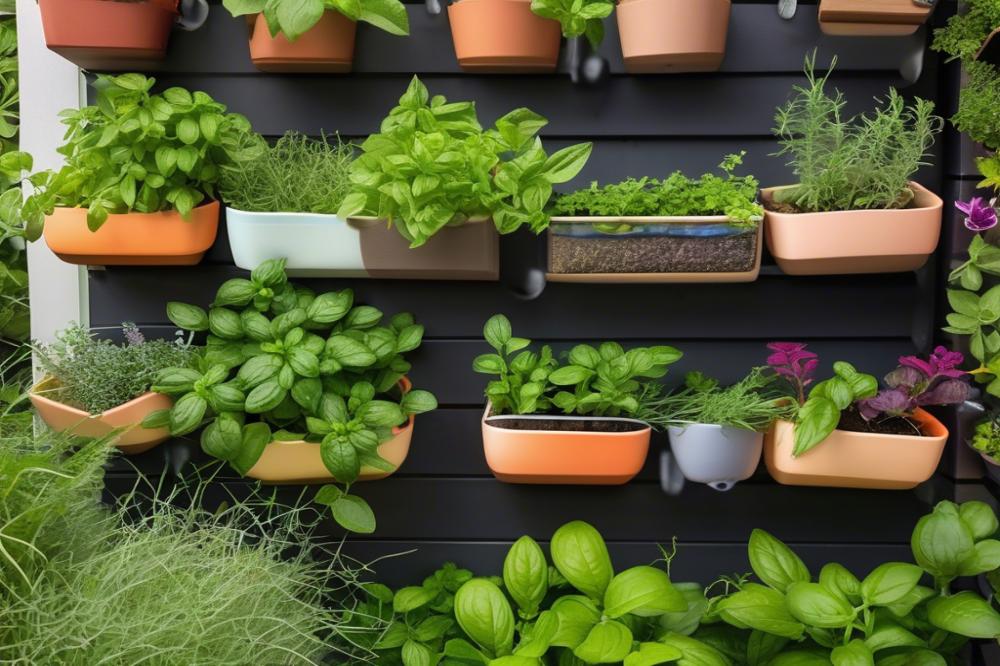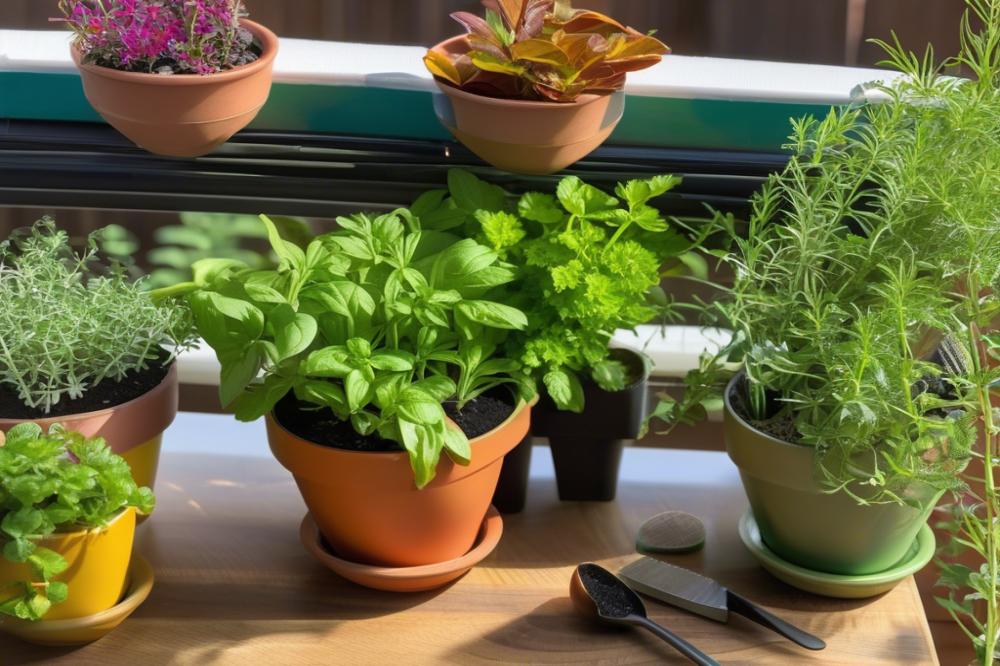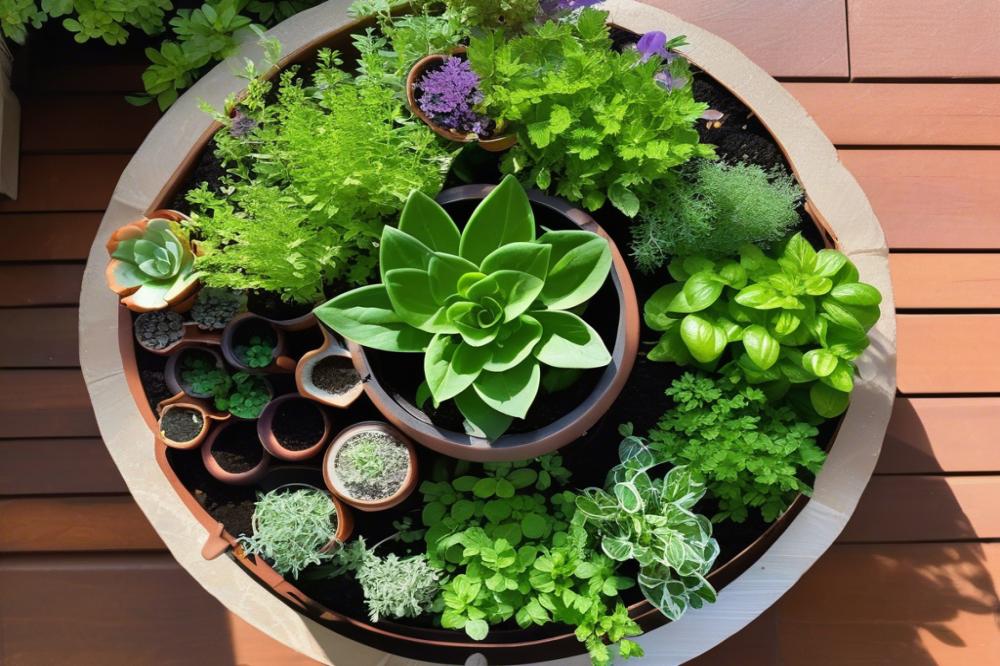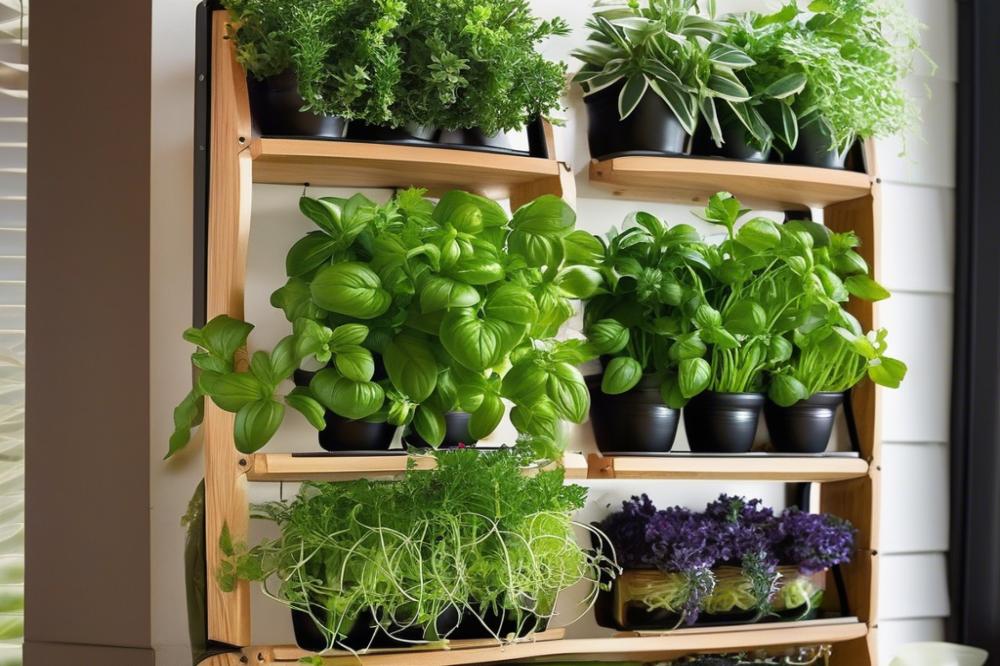Designing a Small Space herb garden
herb gardens are essential, especially in small spaces where every inch counts. Many people enjoy cooking, and fresh herbs can elevate any dish. Small indoor herb gardens provide easy access to flavors that enhance meals. Beyond cooking, growing herbs can also promote wellness. Many herbs have healing properties and can be part of a healthier lifestyle.
Container gardening is an excellent method for those looking to maximize limited space. With just a few pots, anyone can start a DIY herb garden right on a patio, balcony, or even a windowsill. You don’t need a backyard to grow flavorful plants. Vertical gardening is another innovative solution. By stacking planters or using wall-mounted containers, you can create a mini-garden without taking up much room.
This article will delve into the different aspects of creating a successful herb garden in small spaces. We’ll explore the best indoor herbs to grow, along with practical gardening tips to ensure their health. Techniques for urban gardening and maintaining your green space will be shared, including ideas for space-saving gardening. Whether you are an experienced gardener or just starting, there’s something here for everyone interested in cultivating edible plants right at home.
Understanding the Basics of an Herb Garden


An herb garden consists of plants that are used for flavoring food, medicinal purposes, and as fragrances. Herb gardening can be done even in limited spaces, making it an appealing option for urban dwellers or anyone looking to grow their own herbs at home.
Types of Herbs Suitable for Small Spaces
Growing herbs can be a satisfying activity. indoor herbs are perfect for small environments. Popular choices include basil, mint, and parsley. These plants thrive on windowsills and require minimal space. container gardening is another great way to cultivate herbs. Options such as rosemary and chives do well in pots. Vertical gardening can maximize your space further, allowing you to grow multiple plants in a compact area. This technique works well for climbing or trailing herbs, like thyme.
Seasonal Considerations for Herb Gardening
Seasons play a significant role in herb gardening. Some herbs flourish in warm weather while others prefer cool temperatures. It’s essential to know which herbs grow best in each season. For instance, parsley can withstand cooler weather, whereas basil loves the summer sun. Planning ahead can help you enjoy fresh herbs year-round. Whether you are engaging in DIY herb garden projects or simply using existing plants, you will need to consider these factors. Urban gardening enthusiasts can have success by planting based on seasonal changes as well. Gardening tips can guide you as you rotate your herbs with the seasons.
Choosing the Right Containers for Your Herb Garden


Container gardening offers many benefits, especially in small spaces. This method allows anyone to enjoy fresh, indoor herbs without needing a large yard. Urban gardening can be made simpler and more appealing when you select the right containers. They can easily fit on windowsills, balconies, or even in small corners of a home.
Types of Containers: Size, Material, and Drainage Considerations
When it comes to choosing pots, size matters. Small containers are perfect for growing herbs like basil and mint. However, larger ones may be more suitable for plants with extensive root systems, such as rosemary. Different materials can also influence growth. Clay pots are lovely and allow air to circulate but can dry out quicker. Plastic containers, on the other hand, retain moisture better, making them ideal for some indoor herbs.
Drainage is essential. Every container should have holes at the bottom to let excess water escape. Without proper drainage, roots can rot, leading to unhealthy plants. Adding a layer of pebbles or gravel at the bottom can enhance drainage, supporting healthy root development.
Best Practices for Potting Herbs and Ensuring Healthy Root Development
Potting herbs requires attention to detail. Start with high-quality potting soil to give your plants a strong foundation. Mixing in compost can provide nutrients that will help them thrive. When planting, avoid burying the stems too deeply. This can suffocate the roots and stunt growth.
Watering is a critical part of growing herbs. Always check the soil moisture before watering. If the top inch is dry, it’s time to water. Overwatering is a common mistake in container gardening that can lead to problems. Adjust your watering schedule based on the season and the type of plants you’re growing.
Consider vertical gardening if space is limited. It’s a creative way to maximize your growing area. Using shelves or wall-mounted planters can allow you to grow multiple types of edible plants in a small footprint. Explore DIY herb garden kits, which can offer exciting options for urban gardening enthusiasts.
Maximizing Space with Vertical Gardening


Vertical gardening is a smart way to grow herbs when space is limited. This method uses vertical structures to support plant growth, rather than spreading out on the ground. It takes advantage of height, allowing urban gardeners to create lush green spaces even in small apartments. The benefits are many: it increases growing area, improves air circulation, and adds visual interest to any room. When done correctly, vertical gardens can become living art pieces.
Types of Vertical Gardening Systems Suitable for Herbs
Many systems exist for creating a vertical herb garden. Wall-mounted planters are popular for smaller spaces, like kitchens. They can often hold multiple pots filled with indoor herbs. Another option involves using shelves with containers. These allow easy access to herbs while maximizing sunlight exposure. Hydroponic systems, where plants grow in nutrient-rich water instead of soil, are also worth considering. Such systems provide excellent yields and are particularly suited for those who want to try container gardening.
How to Design a Vertical Herb Garden Structure for Optimal Sunlight
Designing a vertical structure is crucial for successful herb growing. Start by assessing the sunlight in your space. Herbs such as basil and rosemary thrive in bright light, so position your garden where they will get at least six hours of sunlight daily. Using a south-facing wall can often yield the best results. Also, consider the height of your structure. Taller plants should be at the bottom, allowing shorter varieties to capture sunlight above. This arrangement helps ensure that all plants receive adequate light throughout the day.
When creating a DIY herb garden, think about the materials you use. Wood, metal, or even repurposed items can all function well for vertical gardening. Arrange plants by their light and water needs. Regularly check for signs of growth and adjust the positioning if necessary. Follow these gardening tips to cultivate a vibrant space filled with edible plants.
Utilizing Windowsills for Indoor herb gardens


Windowsills are perfect for growing indoor herbs, especially in small apartments. This space often receives ample sunlight, which many edible plants crave. Herbs like basil and parsley thrive in this bright environment. Growing fresh herbs close at hand can enhance cooking and make meals more flavorful.
Benefits of Windowsill Herbs in Small Apartments
Indoor herbs bring life to any space. They not only beautify but also provide fresh ingredients for cooking. For those interested in urban gardening, these small plants are a productive addition. Container gardening allows anyone to grow herbs without needing a large outdoor space. They often require little maintenance, making them suitable for busy lifestyles.
Best Herbs to Grow on Windowsills: Light and Water Requirements
Consider herbs that need plenty of sunlight. Basil, chives, and thyme are well-suited for sunny windowsills. These varieties flourish in bright light, typically requiring at least six hours each day. While watering needs vary, most herbs prefer soil that is slightly damp but not waterlogged. Overwatering can lead to root rot, so it’s important to check the moisture level before adding more water.
Tips for Maintaining Healthy Indoor Herbs
Consistency is key for successful growing herbs indoors. Position pots to catch the most sunlight. Rotate them occasionally to promote even growth. Additionally, a good drain hole in each container prevents excess water from building up. Fertilize the soil every couple of weeks to provide necessary nutrients.
Consider vertical gardening solutions if space is limited. Hanging pots or wall-mounted planters save room while creating an attractive display. Pairing different herbs together can create a delightful mini garden too. As seasons change, keep an eye on your plants and adjust care accordingly.
Using these gardening tips, anyone can successfully create their own DIY herb garden in a small space. Not only do windowsill herbs add flavor to cooking, but they also bring a touch of nature indoors.
Urban Gardening Techniques for Small Space Herb Gardens
Urban gardening encompasses a variety of methods designed to cultivate plants in limited spaces. In crowded cities, many people find it challenging to grow their own food. Yet, innovative techniques like container gardening can make it possible. With just a few pots on a balcony or patio, individuals can enjoy fresh indoor herbs throughout the year.
Community Gardens and Sharing Resources
Community gardens play a key role in connecting local residents. These shared spaces allow people to plant, tend, and harvest together. Joining one gives individuals the chance to learn from others and share resources. Participants benefit from collective knowledge and support. Many cities have established these gardens to promote food accessibility and environmental awareness.
Sustainable Practices for Growing Herbs in Urban Settings
Choosing sustainable practices is important for those growing herbs. Utilizing rainwater collection systems can help conserve water. This method can also reduce the reliance on tap water. Composting kitchen scraps and garden waste creates rich soil without chemical fertilizers. Vertical gardening is another effective way to maximize limited space. By using walls or fences, people can grow a variety of edible plants more easily. This method also attracts beneficial insects and enhances overall garden health.
Herb gardening can thrive on windowsills. It’s simple to place potted herbs near sunlight. This method allows anyone to enjoy flavors like basil or mint right from home. Gardening tips often emphasize the importance of light and air circulation. Taking advantage of these factors helps indoor herbs flourish.
Space-saving gardening techniques allow urban dwellers to grow what they love. A DIY herb garden can fit into any nook, whether on a counter or balcony. Small containers can dazzle with vibrant colors while offering fresh flavors. Each unique plant adds beauty and utility to any living space.
Explore diverse approaches to cultivate your own little patch of greenery. Urban gardening isn’t just about aesthetics; it’s also about sustainability and community. Getting involved in local efforts enhances the experience. With creativity and commitment, anyone can transform their small urban space into an inviting herb haven.
DIY Herb Garden Projects
Creating a small space herb garden is a fun project anyone can try. Several simple ideas can help you get started. One popular method involves using old containers. You might have tin cans, glass jars, or even wooden crates lying around. These can make excellent homes for your indoor herbs.
Container gardening allows you to use any available space. Hang baskets filled with soil and seeds on your balcony or patio. Vertical gardening is also a fantastic option for tight spots. Stack planters on top of each other to maximize the space. This design not only saves room but also creates a beautiful green wall.
Crafting Your Own Planters
Personalizing your planters can showcase your style. Paint or decorate old containers to make them your own. You could also add labels for each herb. This helps you remember what you’re growing, and it looks nice too. Some people even use repurposed materials like wooden pallets or old shoe organizers to house their edible plants.
Windowsill herbs are another excellent alternative. They require minimal care and bring fresh flavors right to your kitchen. Simple wooden boxes can hold several small pots. Place them on your sill and enjoy the sunshine every day. You may try growing herbs like basil, cilantro, or parsley that thrive in smaller environments.
Gardening Tips for Success
Don’t forget about light when planning your garden setup. Most herbs need plenty of sunlight to flourish. If you are living in an urban area with limited exposure, consider using grow lights. These can provide the necessary light for your plants. Keeping them healthy boosts your chances of a successful harvest.
You should also think about soil. Using high-quality potting mix is essential for growing herbs effectively. Drainage holes in containers help prevent root rot. Checking for pests regularly protects your plants. Try to catch any issues early for the best results.
Remind yourself that creating your DIY herb garden allows for creativity and expression. Feel free to experiment with different layouts or plant combinations. Consider mixing herbs with flowers for a more colorful display. Your unique garden is a reflection of your personal touch. Each decision can make your project special to you.
Gardening Tips for Growing a Successful Herb Garden
Watering is a crucial part of herb care. Overwatering can lead to root rot. This is a common mistake among new gardeners. It’s best to allow the soil to dry out slightly between watering sessions. On the other hand, indoor herbs need consistent moisture, especially in dry environments. Always check the soil with your finger. If it feels dry about an inch down, it’s time to water.
Sunlight is another essential aspect to consider. Many herbs thrive in bright, indirect light. Position your pots near windows—especially the south-facing ones. For those involved in urban gardening or container gardening, using grow lights can be beneficial. They simulate the sunlight that herbs need to grow. Rotate your plants every few weeks to promote even growth.
Harvesting Techniques
Harvesting herbs can encourage further growth. Snipping the leaves regularly prevents your plants from becoming too leggy. Use clean scissors to make cuts just above a leaf node to stimulate new shoots. Remember to take only a small amount at a time. This practice promotes healthy growth and keeps your plants lush.
Pest Management
Common pests can be a challenge for any gardener. Aphids, spider mites, and whiteflies often target tender edible plants. Inspect your herbs regularly for signs of these pests. If you see any, you can treat them with soapy water or insecticidal soap. Neem oil is another option that works well. Always follow the directions when using any spray.
Seasonal Care
Preparing herbs for seasonal changes can greatly affect their health. During the winter, many herbs need protection from cold drafts. You might bring your pots indoors or cover them with cloches. This keeps the warmth while allowing them to survive. When summer arrives, keep an eye on moisture levels. Containers can dry out faster in the heat.
Vertical gardening is a creative way to maximize space. This method works particularly well if you have limited room. Use vertical planters or hanging pots to save space while still growing plenty of herbs. This can transform any small space into a vibrant garden.
Starting a DIY herb garden can be a rewarding experience. Select herbs that you frequently use in your cooking. Basil, mint, rosemary, and parsley are great options for beginners. Mix and match with windowsill herbs for easy access. Taking the time to care for your plants will lead to a thriving collection of fresh flavors.
Final Thoughts on Your Herb Garden Journey
Creating a small space for growing herbs brings many advantages. Fresh flavors and vibrant aromas can enhance your cooking. Additionally, nurturing plants can improve your mood and reduce stress. Having a touch of green at home adds a lively atmosphere. You also gain the satisfaction of harvesting your own ingredients.
Starting your own garden is easier than it seems. All you need is a few pots, some quality soil, and the right herbs that suit your tastes. Whether it’s basil, mint, or rosemary, each plant contributes its own charm. Container gardening allows you to tend to your herbs on a balcony, windowsill, or even a small patio. Whatever the space, you can make it work.
Gardening brings joy and a sense of accomplishment. Watching your plants grow teaches patience and care. Indoor herbs can transform your meals from ordinary to extraordinary. Just imagine snipping fresh leaves right before adding them to your dish. This connection to your food is rewarding.
In closing, embrace the journey of growing herbs at home. Each step will lead to new discoveries and delights. Take a moment to enjoy the simple pleasure of caring for plants. This small endeavor can elevate both your cooking and your spirit.



